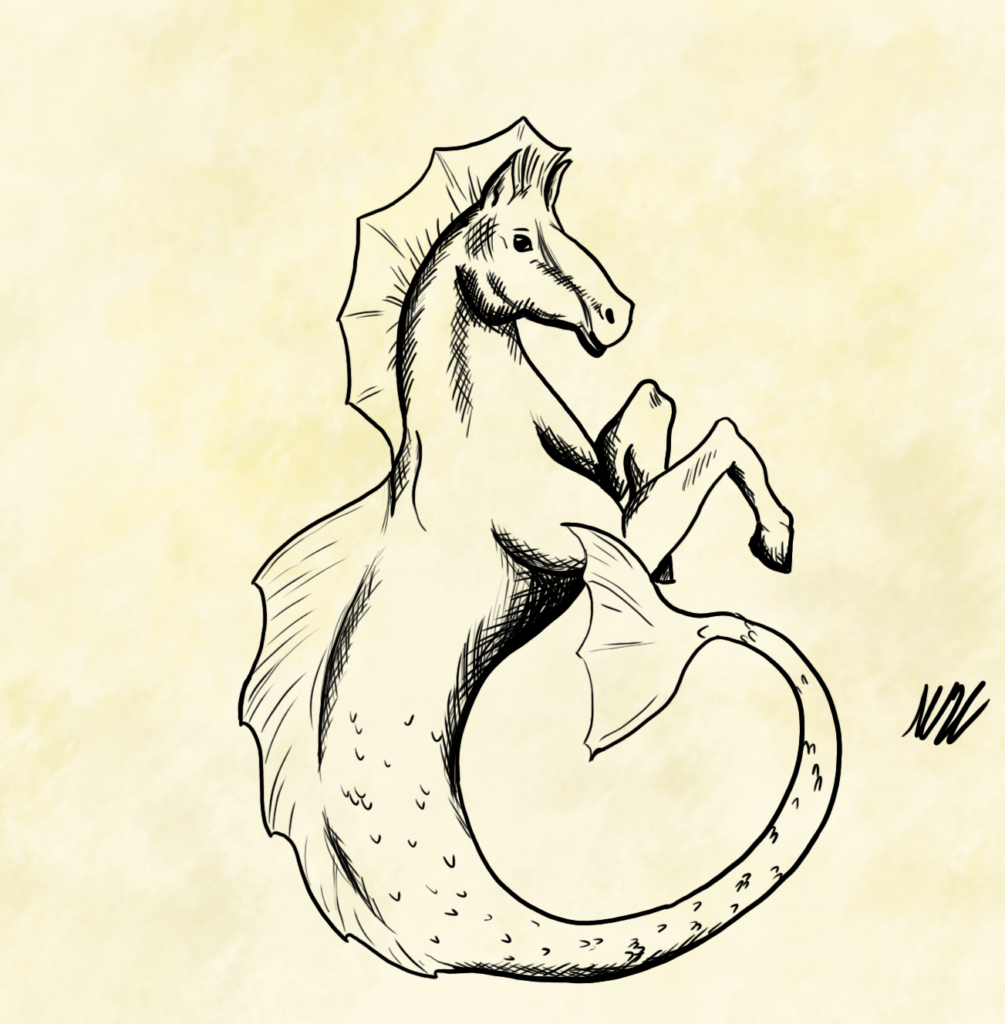Hippocamp / Hippokampos / Hippokampoi / ἱππόκαμπος
The Hippocampus (plural: Hippocampoi or Hippokampoi), also known as Hippocamp or Hippokampos in Greek mythology, is a mythological creature with the upper body of a horse and the lower body of a fish. The name “Hippocampus” comes from the Greek words “hippos” (ἵππος) meaning “horse” and “kampos” (κάμπος) meaning “sea monster.” These creatures were often associated with the sea god Poseidon (known as Neptune in Roman mythology) and played a significant role in ancient Greek seafaring culture.


Appearance
In artistic depictions, the Hippocampus is often shown pulling the chariot of Poseidon or swimming through the waves alongside other sea creatures. They are portrayed as graceful, majestic, and swift beings, perfectly adapted to life in the water
The Hippocampus is depicted as a hybrid creature, with the front half resembling a horse, complete with a mane, hooves, and a strong, muscular neck and head. The back half of its body transforms into a fish-like tail, often portrayed as sleek and scaled, similar to that of a dolphin or other marine animals.
Role in Greek and Roman Mythology
- Association with Poseidon:
- The Hippocampus is closely linked with Poseidon, the god of the sea, earthquakes, and horses. In many depictions, the Hippocampi are shown drawing Poseidon’s chariot through the sea, symbolizing the god’s dominion over both the oceans and horses.
- As creatures of Poseidon’s realm, Hippocampi represent the natural connection between horses and the sea, a symbol of power, beauty, and freedom in both elements. They serve as both companions and steeds for Poseidon, reinforcing his divine status as lord of all sea creatures.
- Symbol of Safe Passage:
- For ancient seafarers, the Hippocampus was often seen as a protective symbol, representing the hope for a safe journey across the sea. Sailors and travelers would pray to Poseidon and offer sacrifices, sometimes invoking the Hippocampus as a symbol of good fortune and smooth sailing.
- In some interpretations, Hippocampi were said to aid sailors in navigating through rough waters, guiding ships safely to shore.
- Tritons and Other Sea Creatures:
- The Tritons, the merman-like servants of Poseidon, are often depicted riding Hippocampi. These scenes appear in both Greek and Roman art, especially on mosaics and pottery. Tritons themselves are hybrid creatures, half-human and half-fish, and they represent the male counterparts of the mermaids. Riding Hippocampi into battle or while escorting Poseidon reinforces their role as the god’s attendants.
- Roman Influence:
- The Romans adopted the myth of the Hippocampus from Greek tradition, and it became a popular figure in Roman art and mosaics. The Roman sea god Neptune was also depicted with Hippocampi pulling his chariot, and the creature continued to symbolize the majestic power of the sea.
- In Roman villas, mosaics of Hippocampi were often used to decorate baths, fountains, and seaside buildings, reflecting their association with water and seafaring.
Symbolism of the Hippocampus
- Harmony of Land and Sea:
- As a fusion of a horse and a fish, the Hippocampus represents the harmony between the land and sea. Horses are symbols of strength, freedom, and nobility, while the fish tail represents the fluidity and mystery of the ocean. Together, they form a perfect union of two natural elements, embodying the balance between two realms.
- Power and Grace:
- Like horses, the Hippocampus is often seen as a noble and powerful creature, symbolizing both speed and grace. Its role in transporting Poseidon through the waves elevates it to a divine status, making it an emblem of divine power and regal beauty.
- Sea Voyages and Exploration:
- The Hippocampus, as a mythical sea horse, also serves as a protector of sailors and travelers. It was believed to help guide ships and represent safe passage across treacherous waters. As such, it was seen as a positive symbol for exploration, trade, and the adventurous spirit of those who ventured out onto the open sea.
- Art and Culture:
- The Hippocampus frequently appeared in ancient Greek and Roman mosaics, coins, and sculpture, particularly in settings connected to the sea. It symbolized not just Poseidon’s power but also the respect and reverence for the ocean as a vital part of ancient life, especially in coastal cities.
Modern Connections
- Taxonomy:
- Interestingly, the word hippocampus is now used in modern science to describe the seahorse, a real-life marine creature that somewhat resembles the mythical Hippocampus in its horse-like head and curled tail.
- Additionally, the hippocampus is the name of a part of the human brain associated with memory and navigation, likely drawing from the Greek and Roman use of the creature as a guide through the seas.
- Popular Culture:
- The Hippocampus has appeared in various forms of modern literature, fantasy, and popular culture. It is often depicted in books, films, and video games as a sea creature with magical powers, sometimes even ridden by characters as they travel across the ocean.
- The creature remains a symbol of the mystical and mythical nature of the sea, often featured in fantasy settings that evoke ancient Greek or Roman mythology.
- Heraldry:
- The Hippocampus also appears in heraldry, particularly in coats of arms and seals for cities or families with a connection to the sea. As a symbol of strength, nobility, and safe navigation, it is used to represent the power and majesty of the ocean.
Conclusion
The Hippocampus is a majestic and powerful creature of Greek and Roman mythology, symbolizing the divine union between the sea and the land. As a servant of Poseidon/Neptune, it embodies grace, speed, and protection for sailors and those venturing across the oceans. The image of the Hippocampus continues to captivate the imagination in modern times, reflecting humanity’s fascination with the sea and the mysterious creatures that inhabit both myth and reality.
Description

The hippocampus or hippocamp, often called sea-horse in English, is a creature from Phonecian, Etruscan, Roman, and Greek mythology. [1] It is described as having the upper body of a horse, including the front legs, and the lower body of a fish.
The word hippocampus comes from the combination of the Greek word ἵππος, meaning “horse” and κάμπος, meaning “sea monster”. [2]
Greek and Roman
The Argonautica describes Orion grasping the reins of Poseidon’s “two-hoofed horses” describing hippocampus [3] and in Hellenistic and Roman imagery Neptune drives a chariot drawn by hippocampi.
Etruscan
The hippocampi are a common theme in Etruscan tomb wall-paintings and reliefs. [4] There is some belief that Etruscan myth believed that the way to the afterlife entailed a sea-voyage which would imply a great symbolism in the placement of hippocampi. [5]
Renaissance
In the Renaissance the hippocampus became a popular symbol used as a heraldic charge or a shield. It is also a common image in Renaissance and Baroque art and sculptures.
Similar Myths
In Pictish and Scottish myths, the Kelpie share many similarities with the hippocampi.
The Capricorn, aigikampoi or sea-goat is also commonly associated with the hippocampus due to their similar appearance and their connection with the ocean.
Other Etruscan creatures with similar physical characteristics are the leokampoi, taurokampoi, and pardalokampoi.
Sources:
[1]: The hyphen distinguishes from the seahorse, a real fish.
[2]: Word origin of Hippocampus at reference.com; compare the monster Campe.
[3]: Valerius Flaccus, Argonautica 2.507.
[4]: Etruscan sea creatures, including a range of hippocampi, are set in cultural context and ordered by typology in Monika Boosen, Etruskische Meeresmischwesen: Untersuchungen zur Typologie u. Bedeutung (Archaeologica 59) (Rome:Bretschneider) 1986.
[5]: Katharine Shepard, The Fish-Tailed Monster in Greek and Etruscan Art, 1940, pp 25ff; the thesis was, exceptionally, reviewed (by G.W. Elderkin) in American Journal of Archaeology 45.2 (April 1941), pp. 307-308: available on-line through JSTOR.
Author

Josh Morley holds a Bachelor’s degree in Theology from the Trinity School of Theology and a Diploma in Theology from the Bible College of Wales. His academic journey involved interfaith community projects and supporting international students, experiences that shaped his leadership and reflective skills. Now based in Liverpool, Josh is also the founder of Marketing the Change, a digital agency specializing in web design and marketing.
View all posts




